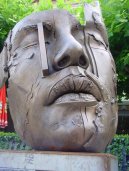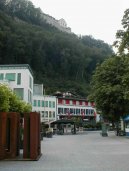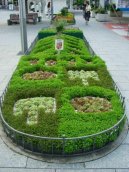| Introduction - Liechtenstein: |
Country | Liechtenstein |
|
Background | The Principality of Liechtenstein was established within the Holy Roman Empire in 1719; it became a sovereign state in 1806. Until the end of World War I, it was closely tied to Austria, but the economic devastation caused by that conflict forced Liechtenstein to enter into a customs and monetary union with Switzerland. Since World War II (in which Liechtenstein remained neutral), the countrys low taxes have spurred outstanding economic growth. Shortcomings in banking regulatory oversight resulted in concerns about the use of financial institutions for money laundering. However, Liechtenstein implemented anti-money-laundering legislation over the past several years and a Mutual Legal Assistance Treaty with the US went into effect in 2003. |
|
|
|
| Location - Liechtenstein: |
Location | Central Europe, between Austria and Switzerland |
|
Geographic coordinates | 47 16 N, 9 32 E |
|
Map references | Europe |
|
Area | total: 160 sq km
land: 160 sq km
water: 0 sq km |
|
Area comparative | about 0.9 times the size of Washington, DC |
|
Land boundaries | total: 76 km
border countries: Austria 34.9 km, Switzerland 41.1 km |
|
Coastline | 0 km (doubly landlocked) |
|
Maritime claims | none (landlocked) |
|
Climate | continental; cold, cloudy winters with frequent snow or rain; cool to moderately warm, cloudy, humid summers |
|
Terrain | mostly mountainous (Alps) with Rhine Valley in western third |
|
Elevation extremes | lowest point: Ruggeller Riet 430 m
highest point: Vorder-Grauspitz 2,599 m |
|
Natural resources | hydroelectric potential, arable land |
|
Land use | arable land: 25%
permanent crops: 0%
other: 75% (2005) |
|
Irrigated land | NA |
|
Natural hazards | NA |
|
Environment current issues | NA |
|
Environment international agreements | party to: Air Pollution, Air Pollution-Nitrogen Oxides, Air Pollution-Persistent Organic Pollutants, Air Pollution-Sulfur 85, Air Pollution-Sulfur 94, Air Pollution-Volatile Organic Compounds, Biodiversity, Climate Change, Climate Change-Kyoto Protocol, Desertification, Endangered Species, Hazardous Wastes, Ozone Layer Protection, Wetlands
signed, but not ratified: Law of the Sea |
|
Geography note | along with Uzbekistan, one of only two doubly landlocked countries in the world; variety of microclimatic variations based on elevation |
|
| People - Liechtenstein: |
Population | 34,247 (July 2007 est.) |
|
Age structure | 0-14 years: 17.1% (male 2,902/female 2,963)
15-64 years: 70% (male 11,887/female 12,101)
65 years and over: 12.8% (male 1,862/female 2,532) (2007 est.) |
|
Median age | total: 40.1 years
male: 39.5 years
female: 40.5 years (2007 est.) |
|
Population growth rate | 0.745% (2007 est.) |
|
Birth rate | 10.02 births/1,000 population (2007 est.) |
|
Death rate | 7.3 deaths/1,000 population (2007 est.) |
|
Net migration rate | 4.73 migrant(s)/1,000 population (2007 est.) |
|
Sex ratio | at birth: 1.01 male(s)/female
under 15 years: 0.979 male(s)/female
15-64 years: 0.982 male(s)/female
65 years and over: 0.735 male(s)/female
total population: 0.946 male(s)/female (2007 est.) |
|
Infant mortality rate | total: 4.58 deaths/1,000 live births
male: 6.13 deaths/1,000 live births
female: 3.02 deaths/1,000 live births (2007 est.) |
|
Life expectancy at birth | total population: 79.81 years
male: 76.24 years
female: 83.4 years (2007 est.) |
|
Total fertility rate | 1.51 children born/woman (2007 est.) |
|
Hiv aids adult prevalence rate | NA |
|
Hiv aids people living with hiv aids | NA |
|
Hiv aids deaths | NA |
|
Nationality | noun: Liechtensteiner(s)
adjective: Liechtenstein |
|
Ethnic groups | Alemannic 86%, Italian, Turkish, and other 14% |
|
Religions | Roman Catholic 76.2%, Protestant 7%, unknown 10.6%, other 6.2% (June 2002) |
|
Languages | German (official), Alemannic dialect |
|
Literacy | definition: age 10 and over can read and write
total population: 100%
male: 100%
female: 100% |
|
| Government - Liechtenstein: |
Country name | conventional long form: Principality of Liechtenstein
conventional short form: Liechtenstein
local long form: Fuerstentum Liechtenstein
local short form: Liechtenstein |
|
Government type | constitutional monarchy |
|
Capital | name: Vaduz
geographic coordinates: 47 08 N, 9 31 E
time difference: UTC+1 (6 hours ahead of Washington, DC during Standard Time)
daylight saving time: +1hr, begins last Sunday in March; ends last Sunday in October |
|
Administrative divisions | 11 communes (Gemeinden, singular - Gemeinde); Balzers, Eschen, Gamprin, Mauren, Planken, Ruggell, Schaan, Schellenberg, Triesen, Triesenberg, Vaduz |
|
Independence | 23 January 1719 (Principality of Liechtenstein established); 12 July 1806 (independence from the Holy Roman Empire) |
|
National holiday | Assumption Day, 15 August |
|
Constitution | 5 October 1921 |
|
Legal system | local civil and penal codes based on civil law system; accepts compulsory ICJ jurisdiction with reservations |
|
Suffrage | 18 years of age; universal |
|
Executive branch | chief of state: Prince HANS ADAM II (since 13 November 1989, assumed executive powers 26 August 1984); Heir Apparent Prince ALOIS, son of the monarch (born 11 June 1968); note - on 15 August 2004, HANS ADAM transferred the official duties of the ruling prince to ALOIS, but HANS ADAM retains status of chief of state
head of government: Head of Government Otmar HASLER (since 5 April 2001); Deputy Head of Government Klaus TSCHUETSCHER (since 21 April 2005)
cabinet: Cabinet elected by the Parliament, confirmed by the monarch
elections: none; the monarch is hereditary; following legislative elections, the leader of the majority party in the Landtag is usually appointed the head of government by the monarch and the leader of the largest minority party in the Landtag is usually appointed the deputy head of government by the monarch if there is a coalition government |
|
Legislative branch | unicameral Parliament or Landtag (25 seats; members are elected by popular vote under proportional representation to serve four-year terms)
elections: last held 11 and 13 March 2005 (next to be held by 2009)
election results: percent of vote by party - FBP 48.7%, VU 38.2%, FL 13%; seats by party - FBP 12, VU 10, FL 3 |
|
Judicial branch | Supreme Court or Oberster Gerichtshof; Court of Appeal or Obergericht |
|
Political parties and leaders | Patriotic Union or VU [Adolf HEEB] (was Fatherland Union); Progressive Citizens Party or FBP [Otmar HASLER]; The Free List or FL [Claudia HEEB-FLECK and Egon MATT] |
|
Political pressure groups and leaders | NA |
|
International organization participation | CE, EBRD, EFTA, IAEA, ICCt, ICRM, IFRCS, Interpol, IOC, IPU, ITSO, ITU, OPCW, OSCE, PCA, UN, UNCTAD, UPU, WCL, WIPO, WTO |
|
Diplomatic representation in the us | chief of mission: Ambassador Claudia FRITSCHE
chancery: 888 17th Street NW, Suite 1250, Washington, DC 20006
telephone: [1] (202) 331-0590
FAX: [1] (202) 331-3221 |
|
Diplomatic representation from the us | the US does not have an embassy in Liechtenstein; the US Ambassador to Switzerland is accredited to Liechtenstein |
|
Flag description | two equal horizontal bands of blue (top) and red with a gold crown on the hoist side of the blue band |
|
| Economy - Liechtenstein: |
Economy overview | Despite its small size and limited natural resources, Liechtenstein has developed into a prosperous, highly industrialized, free-enterprise economy with a vital financial service sector and living standards on a par with its large European neighbors. The Liechtenstein economy is widely diversified with a large number of small businesses. Low business taxes - the maximum tax rate is 20% - and easy incorporation rules have induced many holding or so-called letter box companies to establish nominal offices in Liechtenstein, providing 30% of state revenues. The country participates in a customs union with Switzerland and uses the Swiss franc as its national currency. It imports more than 90% of its energy requirements. Liechtenstein has been a member of the European Economic Area (an organization serving as a bridge between the European Free Trade Association (EFTA) and the EU) since May 1995. The government is working to harmonize its economic policies with those of an integrated Europe. |
|
Gdp purchasing power parity | $1.786 billion (2001 est.) |
|
Gdp official exchange rate | $2.487 billion (2001) |
|
Gdp real growth rate | 11% (1999 est.) |
|
Gdp per capita ppp | $25,000 (1999 est.) |
|
Gdp composition by sector | agriculture: 6%
industry: 39%
services: 55% (2001) |
|
Labor force | 29,500 of whom 13,900 commute from Austria, Switzerland, and Germany to work each day (31 December 2001) |
|
Labor force by occupation | agriculture: 2%
industry: 47%
services: 51% (31 December 2001 est.) |
|
Unemployment rate | 1.3% (September 2002) |
|
Population below poverty line | NA% |
|
Household income or consumption by percentage share | lowest 10%: NA%
highest 10%: NA% |
|
Inflation rate consumer prices | 1% (2001) |
|
Budget | revenues: $424.2 million
expenditures: $414.1 million; including capital expenditures of $NA (1998 est.) |
|
Agriculture products | wheat, barley, corn, potatoes; livestock, dairy products |
|
Industries | electronics, metal manufacturing, dental products, ceramics, pharmaceuticals, food products, precision instruments, tourism, optical instruments |
|
Industrial production growth rate | NA% |
|
Exports | $2.47 billion (1996) |
|
Exports commodities | small specialty machinery, connectors for audio and video, parts for motor vehicles, dental products, hardware, prepared foodstuffs, electronic equipment, optical products |
|
Exports partners | EU 62.6% (Germany 24.3%, Austria 9.5%, France 8.9%, Italy 6.6%, UK 4.6%), US 18.9%, Switzerland 15.7% (2006) |
|
Imports | $917.3 million (1996) |
|
Imports commodities | agricultural products, raw materials, energy products, machinery, metal goods, textiles, foodstuffs, motor vehicles |
|
Imports partners | EU, Switzerland (2006) |
|
Debt external | $0 (2001) |
|
Currency code | Swiss franc (CHF) |
|
Exchange rates | Swiss francs per US dollar - 1.2539 (2006), 1.2452 (2005), 1.2435 (2004), 1.3467 (2003), 1.5586 (2002) |
|
| Communications - Liechtenstein: |
Fiscal year | calendar year |
|
Telephones main lines in use | 20,000 (2005) |
|
Telephones mobile cellular | 27,500 (2005) |
|
Telephone system | general assessment: automatic telephone system
domestic: NA
international: country code - 423; linked to Swiss networks by cable and microwave radio relay |
|
Radio broadcast stations | AM 0, FM 4, shortwave 0 (1998) |
|
Television broadcast stations | NA (linked to Swiss networks) (1997) |
|
Internet country code | .li |
|
Internet hosts | 4,697 (2006) |
|
Internet users | 22,000 (2006) |
|
| Transportation - Liechtenstein: |
Pipelines | gas 20 km (2006) |
|
Railways | 9 km 1.435-m gauge (electrified)
note: belongs to the Austrian Railway System connecting Austria and Switzerland (2006) |
|
Roadways | total: 380 km
paved: 380 km (2006) |
|
Waterways | 28 km (2006) |
|
Ports and terminals | none |
|
| Military - Liechtenstein: |
Manpower available for military service | males age 18-49: 7,736 (2005 est.) |
|
Manpower fit for military service | males age 18-49: 6,250 (2005 est.) |
|
Military note | defense is the responsibility of Switzerland |
|
Manpower reaching military service age annually | males age 18-49: 208 (2005 est.) |
|
Disputes international | none |
|
This page was last updated on 16 September, 2007



